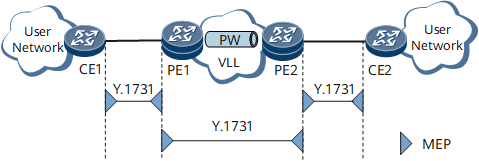Configuring Y.1731 Functions in VLL Networking
This section describes how to configure Y.1731 functions, including single-ended frame loss measurement, dual-ended frame loss measurement, one-way frame delay measurement, and two-way frame delay measurement in VLL networking.
Application Scenario
The VLL technology implements point-to-point VPN networking. As shown in Figure 1, the PEs are connected through a PW. To collect accurate statistics about frame loss on one end of a PW or an AC in VPLS networking, the performance monitoring functions defined by Y.1731 can be used to monitor links.
Pre-configuration Tasks
Before configuring Y.1731 functions in VLL networking, complete the tasks listed in Table 1.
Function |
Pre-configuration Tasks |
|---|---|
Configuring Y.1731 functions (single-ended frame loss measurement, dual-ended frame loss measurement, one-way frame delay measurement, and two-way frame delay measurement) for an AC in VLL networking |
|
Configuring Y.1731 functions (single-ended frame loss measurement, dual-ended frame loss measurement, one-way frame delay measurement, and two-way frame delay measurement) for a PW in VLL networking |
|
- Binding an MA to a VLL
- Binding an MA to a VLL is a prerequisite for configuring single-ended frame loss measurement, dual-ended frame loss measurement, one-way frame delay measurement, two-way frame delay measurement.
- Configuring Single-ended Frame Loss Measurement in VLL Networking
- In VLL networking, CFM is enabled. CCMs are not used to monitor link connectivity, preventing them from using excessive network bandwidth resources. If frame loss measurement needs to be performed for a link, single-ended frame loss measurement can be configured to monitor the link quality.
- Configuring Dual-ended Frame Loss Measurement in VLL Networking
- In VLL networking, CFM is enabled to monitor link connectivity. If accurate frame loss measurement needs to be performed for a link, dual-ended frame loss measurement can be configured to monitor the quality of the link.
- Configuring One-way Frame Delay Measurement in VLL Networking
- In VLL networking, the clock frequencies between the two ends are synchronized and CFM is enabled to monitor link connectivity. If the unidirectional delay measurement needs to be performed for a link, one-way frame delay measurement can be configured to monitor the quality of the link.
- Configuring Two-way Frame Delay Measurement in VLL Networking
- In VLL networking, the clock frequencies between the two ends are not synchronized and CFM is enabled to monitor link connectivity. If the bidirectional delay measurement needs to be performed for a link, two-way frame delay measurement can be configured to monitor the quality of the link.
- Configuring Single-ended SLM in VLL Networking
- This section describes how to configure single-ended synthetic loss measurement (SLM) in virtual leased line (VLL) networking. To collect performance statistics for frame loss on point-to-multipoint or multipoint-to-multipoint links, deploy single-ended SLM, which helps monitor link quality.
- Configuring the ETH-Test Function for a VLL
- The ETH-test function is short for Ethernet test signal. ETH-test instances are performed for a unidirectional on-demand service or during an on-demand-service interruption to calculate parameters, including the maximum bandwidth, frame loss ratio, and bit error rate.
- Configuring AIS
- Configuring AIS prohibits a MEP in an MD of a higher level from sending the same alarm as that sent by a MEP in an MD of a lower level to the NMS.
